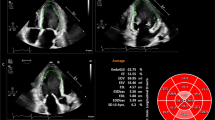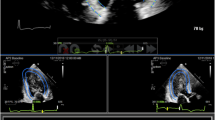Abstract
Ejection fraction (EF) and fractional shortening (FS) are standard methods of quantifying left ventricular (LV) systolic function. 2D global longitudinal strain (2D GLS) is a well-established, but underutilized method for LV function quantification. The aim of this study was to assess precision of GLS compared to EF & FS in pediatrics. Echocardiograms were prospectively analyzed by 2 blinded observers. FS, EF, and GLS were calculated following standard methods. Bland–Altman was applied to assess agreement. Intraclass correlation coefficient (ICC) was used to measure reliability. Coefficient of variation was used to demonstrate relative variability between methods. 103 pediatric echos were evaluated for inter-observer reproducibility, and 15 patients for intra-observer reproducibility. GLS had higher inter-observer agreement and reliability (bias 7%, 95% LOA − 3.4 to + 3.5, ICC 0.86 CI 0.80–0.90) compared to EF (bias 27%, 95% LOA − 18.9 to + 19.5; ICC 0.25 CI 0.07–0.43) and FS (bias 12%, 95% LOA − 11.9 to + 12.2; ICC 0.53 CI 0.38–0.66). GLS also had higher intra-observer agreement (bias 4%, 95% LOA − 3.6 to + 3.7; ICC 0.87 CI 0.66–0.96) compared to EF (bias 11%, 95% LOA − 14.9 to + 15.1; ICC 0.26 CI − 0.28–0.67) and FS (bias 12%, 95% LOA − 12.2 to + 12.5; ICC 0.38 CI − 0.15–0.74). GLS is a more precise method for quantifying LV function in pediatrics, with lower variability compared to EF and FS. GLS provides a more reliable evaluation of LV systolic function and should be utilized more widely in pediatrics.


Similar content being viewed by others
Abbreviations
- GLS:
-
Global longitudinal Lagrangian strain
- ICC:
-
Intraclass correlation coefficient
- CV:
-
Coefficient of variation
- 2D STE:
-
Two-dimensional speckle tracking echocardiography
- LV:
-
Left ventricular
- Obs:
-
Observer
References
Wood PW, Choy JB, Nanda NC, Becher H (2014) Left ventricular ejection fraction and volumes: it depends on the imaging method. Echocardiography 31:87–100
Picard MH, Popp RL, Weyman AE (2008) Assessment of left ventricular function by echocardiography: a technique in evolution. J Am Soc Echocardiogr 21:14–21
Cameli M, Mondillo S, Solari M et al (2016) Echocardiographic assessment of left ventricular systolic function: from ejection fraction to torsion. Heart Fail Rev 21:77–94
Sugimoto T, Dulgheru R, Bernard A et al (2017) Echocardiographic reference ranges for normal left ventricular 2D strain: results from the EACVI NORRE study. Eur Heart J Cardiovasc Imaging 18:833–840
Yingchoncharoen T, Agarwal S, Popović ZB, Marwick TH (2013) Normal ranges of left ventricular strain: a meta-analysis. J Am Soc Echocardiogr 26:185–191
Jashari H, Rydberg A, Ibrahimi P et al (2015) Normal ranges of left ventricular strain in children: a meta-analysis. Cardiovasc Ultrasound 13:37
Levy PT, Machefsky A, Sanchez AA et al (2016) Reference ranges of left ventricular strain measures by two-dimensional speckle-tracking echocardiography in children: a systematic review and meta-analysis. J Am Soc Echocardiogr 29(209–225):e6
Ari ME, Cetin II, Kocabas A, Ekici F, Ceylan O, Surucu M (2016) Decreased deformation in asymptomatic children with isolated left ventricular non-compaction and normal ejection fraction. Pediatr Cardiol 37:201–207
Thavendiranathan P, Poulin F, Lim KD, Plana JC, Woo A, Marwick TH (2014) Use of myocardial strain imaging by echocardiography for the early detection of cardiotoxicity in patients during and after cancer chemotherapy: a systematic review. J Am Coll Cardiol 63:2751–2768
Dandel M, Hetzer R (2017) Post-transplant surveillance for acute rejection and allograft vasculopathy by echocardiography: usefulness of myocardial velocity and deformation imaging. J Heart Lung Transplant 36:117–131
Gunasekaran P, Panaich S, Briasoulis A, Cardozo S, Afonso L (2017) Incremental value of two dimensional speckle tracking echocardiography in the functional assessment and characterization of subclinical left ventricular dysfunction. Curr Cardiol Rev 13:32–40
Kalam K, Otahal P, Marwick TH (2014) Prognostic implications of global LV dysfunction: a systematic review and meta-analysis of global longitudinal strain and ejection fraction. Heart 100:1673–1680
Lopez L, Colan SD, Frommelt PC et al (2010) Recommendations for quantification methods during the performance of a pediatric echocardiogram: a report from the Pediatric Measurements Writing Group of the American Society of Echocardiography Pediatric and Congenital Heart Disease Council. J Am Soc Echocardiogr 23:465–495
Lang RM, Badano LP, Mor-Avi V et al (2015) Recommendations for cardiac chamber quantification by echocardiography in adults: an update from the American Society of Echocardiography and the European Association of Cardiovascular Imaging. J Am Soc Echocardiogr 28(1–39):e14
Systems GM (2008). In: Systems GM (ed) EchoPAC PC user manuel, 1st edn. General Electric Co., Boston, pp. 1–627.
Lorch SM, Ludomirsky A, Singh GK (2008) Maturational and growth-related changes in left ventricular longitudinal strain and strain rate measured by two-dimensional speckle tracking echocardiography in healthy pediatric population. J Am Soc Echocardiogr 21:1207–1215
Takigiku K, Takeuchi M, Izumi C et al (2012) Normal range of left ventricular 2-dimensional strain: Japanese Ultrasound Speckle Tracking of the Left Ventricle (JUSTICE) study. Circ J 76:2623–2632
Yang H, Marwick TH, Fukuda N et al (2015) Improvement in strain concordance between two major vendors after the strain standardization initiative. J Am Soc Echocardiogr 28(642–8):e7
Lee CK, Margossian R, Sleeper LA et al (2014) Variability of M-mode versus two-dimensional echocardiography measurements in children with dilated cardiomyopathy. Pediatr Cardiol 35:658–667
Margossian R, Chen S, Sleeper LA et al (2015) The reproducibility and absolute values of echocardiographic measurements of left ventricular size and function in children are algorithm dependent. J Am Soc Echocardiogr 28(549–558):e1
Chen S, Selamet Tierney ES, Khush KK et al (2015) Reliability of echocardiographic measurements of left ventricular systolic function in potential pediatric heart transplant donors. J Heart Lung Transplant 34:100–106
Korinek J, Wang J, Sengupta PP et al (2005) Two-dimensional strain—a Doppler-independent ultrasound method for quantitation of regional deformation: validation in vitro and in vivo. J Am Soc Echocardiogr 18:1247–1253
Amundsen BH, Helle-Valle T, Edvardsen T et al (2006) Noninvasive myocardial strain measurement by speckle tracking echocardiography: validation against sonomicrometry and tagged magnetic resonance imaging. J Am Coll Cardiol 47:789–793
Geyer H, Caracciolo G, Abe H et al (2010) Assessment of myocardial mechanics using speckle tracking echocardiography: fundamentals and clinical applications. J Am Soc Echocardiogr 23:351–369
Risum N, Ali S, Olsen NT et al (2012) Variability of global left ventricular deformation analysis using vendor dependent and independent two-dimensional speckle-tracking software in adults. J Am Soc Echocardiogr 25:1195–1203
Takahashi M, Harada N, Isozaki Y et al (2013) Efficiency of quantitative longitudinal peak systolic strain values using automated function imaging on transthoracic echocardiogram for evaluating left ventricular wall motion: new diagnostic criteria and agreement with naked eye evaluation by experienced cardiologist. Int J Cardiol 167:1625–1631
Stanton T, Leano R, Marwick TH (2009) Prediction of all-cause mortality from global longitudinal speckle strain: comparison with ejection fraction and wall motion scoring. Circ Cardiovasc Imaging 2:356–364
Pignatelli RH, Ghazi P, Reddy SC et al (2015) Abnormal myocardial strain indices in children receiving anthracycline chemotherapy. Pediatr Cardiol 36:1610–1616
Poterucha JT, Kutty S, Lindquist RK, Li L, Eidem BW (2012) Changes in left ventricular longitudinal strain with anthracycline chemotherapy in adolescents precede subsequent decreased left ventricular ejection fraction. J Am Soc Echocardiogr 25:733–740
Florescu M, Magda LS, Enescu OA, Jinga D, Vinereanu D (2014) Early detection of epirubicin-induced cardiotoxicity in patients with breast cancer. J Am Soc Echocardiogr 27:83–92
Negishi K, Negishi T, Haluska BA, Hare JL, Plana JC, Marwick TH (2014) Use of speckle strain to assess left ventricular responses to cardiotoxic chemotherapy and cardioprotection. Eur Heart J Cardiovasc Imaging 15:324–331
Sarvari SI, Gjesdal O, Gude E et al (2012) Early postoperative left ventricular function by echocardiographic strain is a predictor of 1-year mortality in heart transplant recipients. J Am Soc Echocardiogr 25:1007–1014
Ruotsalainen H, Bellsham-Revell H, Bell A, Pihkala J, Ojala T, Simpson J (2016) Right ventricular systolic function in hypoplastic left heart syndrome: a comparison of velocity vector imaging and magnetic resonance imaging. Eur Heart J Cardiovasc Imaging 17:687–692
Ghelani SJ, Harrild DM, Gauvreau K, Geva T, Rathod RH (2016) Echocardiography and magnetic resonance imaging based strain analysis of functional single ventricles: a study of intra- and inter-modality reproducibility. Int J Cardiovasc Imaging 32:1113–1120
Schlangen J, Petko C, Hansen JH et al (2014) Two-dimensional global longitudinal strain rate is a preload independent index of systemic right ventricular contractility in hypoplastic left heart syndrome patients after Fontan operation. Circ Cardiovasc Imaging 7:880–886
Anwar S, Negishi K, Borowszki A et al (2017) Comparison of two-dimensional strain analysis using vendor-independent and vendor-specific software in adult and pediatric patients. JRSM Cardiovasc Dis 6:2048004017712862
Voigt JU, Pedrizzetti G, Lysyansky P et al (2015) Definitions for a common standard for 2D speckle tracking echocardiography: consensus document of the EACVI/ASE/Industry Task Force to standardize deformation imaging. J Am Soc Echocardiogr 28:183–193
Shiino K, Yamada A, Ischenko M et al (2017) Intervendor consistency and reproducibility of left ventricular 2D global and regional strain with two different high-end ultrasound systems. Eur Heart J Cardiovasc Imaging 18:707–716
Nagata Y, Takeuchi M, Mizukoshi K et al (2015) Intervendor variability of two-dimensional strain using vendor-specific and vendor-independent software. J Am Soc Echocardiogr 28:630–641
Mirea O, Pagourelias ED, Duchenne J et al (2017) Variability and Reproducibility of segmental longitudinal strain measurement: a report from the EACVI-ASE Strain Standardization Task Force. JACC Cardiovasc Imaging 11(1):15–24
Acknowledgements
The authors wish to thank the sonographers and staff at the Heart Station, St. Louis Children’s Hospital for their contributions to echocardiographic acquisitions related to this study.
Funding
This research did not receive any specific grant from funding agencies in the public, commercial, or not-for-profit sectors.
Author information
Authors and Affiliations
Corresponding author
Ethics declarations
Conflict of interest
The authors declare that they have no conflict of interest.
Ethical Approval
This article does not contain any studies with human participants performed by any of the authors. This article does not contain any studies with animals performed by any of the authors.
Additional information
Publisher's Note
Springer Nature remains neutral with regard to jurisdictional claims in published maps and institutional affiliations.
Rights and permissions
About this article
Cite this article
Patel, M.D., Myers, C., Negishi, K. et al. Two-Dimensional Strain is more Precise than Conventional Measures of Left Ventricular Systolic Function in Pediatric Patients. Pediatr Cardiol 41, 186–193 (2020). https://doi.org/10.1007/s00246-019-02243-8
Received:
Accepted:
Published:
Issue Date:
DOI: https://doi.org/10.1007/s00246-019-02243-8




